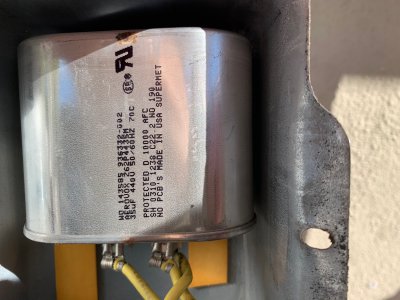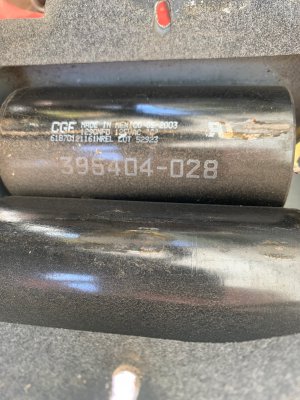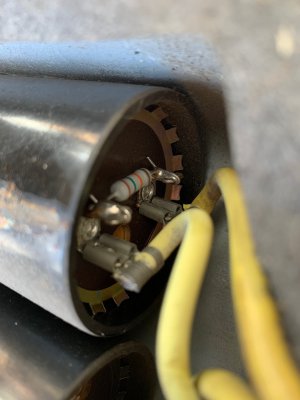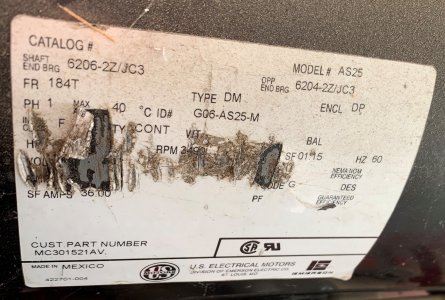- Joined
- Sep 20, 2019
- Messages
- 1,329
Happy Veteran's Day everyone!
I have a 7.5HP air compressor you've helped me with before. It recently began tripping the circuit breaker upon a cycle start - 135 psi I believe. If I let the air out of tank, it worked fine on initial fill cycle, but upon refill, the breaker tripped every time. The mag starter and pressure switch are new, and coincidentally the problem began soon after I replaced them. Now it trips the circuit breaker every time.
I was able to hand turn the pulley and they turn freely with negligible resistance. I removed the drive belt to isolate the pump from the motor, and it still trips the breaker. I'm hoping my problems is simply defective start capacitors. I have minimal experience with this and why I need your help. I believe the capacitor on the top of the motor is the run capacitor. There are two cylindrical capacitors on the side of the motor, and I think they are the run capacitors - and what I hope is my only problem.
I have not put my meter on them, nor tired to discharge them. From what I've read on this site, I should discharge them with resistor, and this is the part that scares me because I've only dealt with small, low voltage capacitors in the past. Note in the pictures the pair of black capacitors have resistors soldered in place from the factory.
How should I proceed? I've read that a 20k OHM, 5 watt resistor is fine for discharging, but would like an expert's opinion. I have a Fluke 87V to test them. If the capacitors are the problem, should I replace all 3 to be safe? What brand/supplier do you recommend? I don't mind spending a little more for quality, as this compressor needs to be reliable.



I have a 7.5HP air compressor you've helped me with before. It recently began tripping the circuit breaker upon a cycle start - 135 psi I believe. If I let the air out of tank, it worked fine on initial fill cycle, but upon refill, the breaker tripped every time. The mag starter and pressure switch are new, and coincidentally the problem began soon after I replaced them. Now it trips the circuit breaker every time.
I was able to hand turn the pulley and they turn freely with negligible resistance. I removed the drive belt to isolate the pump from the motor, and it still trips the breaker. I'm hoping my problems is simply defective start capacitors. I have minimal experience with this and why I need your help. I believe the capacitor on the top of the motor is the run capacitor. There are two cylindrical capacitors on the side of the motor, and I think they are the run capacitors - and what I hope is my only problem.
I have not put my meter on them, nor tired to discharge them. From what I've read on this site, I should discharge them with resistor, and this is the part that scares me because I've only dealt with small, low voltage capacitors in the past. Note in the pictures the pair of black capacitors have resistors soldered in place from the factory.
How should I proceed? I've read that a 20k OHM, 5 watt resistor is fine for discharging, but would like an expert's opinion. I have a Fluke 87V to test them. If the capacitors are the problem, should I replace all 3 to be safe? What brand/supplier do you recommend? I don't mind spending a little more for quality, as this compressor needs to be reliable.





